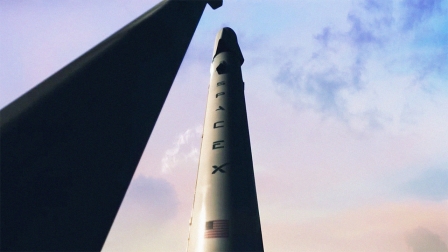Elon Musk’s Mars Mission Revealed: SpaceX’s Interplanetary Transport System
SpaceX founder and CEO Elon Musk presented his company’s plan for transporting humans to Mars, and starting a civilization there to at the International Astronautical Congress in Mexico.
The massive, re-usable rocket—based on existing SpaceX technology—could begin delivering humans to Mars in as little as 40 years and, if he can convince enough people to sign up, the cost would be as little as $200,000 per person.
Prior to his presentation, this video showing the system was released to the public.
Attendees at the conference lined up hours early to get seats for the announcement. And there was a bit of a stampede to get the best seats once the doors finally opened.
Meanwhile, SpaceX’s competitors were using Twitter to respond to the hype.
After a half-hour launch delay, Musk took to the stage. “What I really want to try to achieve here is to make Mars seem possible,” he said. “Make it seem as though it’s something that we can do in our lifetimes, and that you can go.”
But first, a question: “why go anywhere?” he asked.
“History is going to bifurcate along two directions,” Musk continued. “One path is we stay on earth forever, and then there will be some eventual extinction event,” he said, though admitting he doesn’t have any kind of doomsday scenario in mind.
“The alternative is to become a space-faring civilization and a multiplanet species,” said Musk. “Which I hope you’ll agree that is the right way to go.”
With that, he began a detailed explanation of the mission, and how SpaceX would get it done.
Why Mars? Musk explained that early Mars is a lot like Earth. Certainly more so than Venus or even the moons of Jupiter. That’s why it’s the most appealing destination for interplanetary settlements.
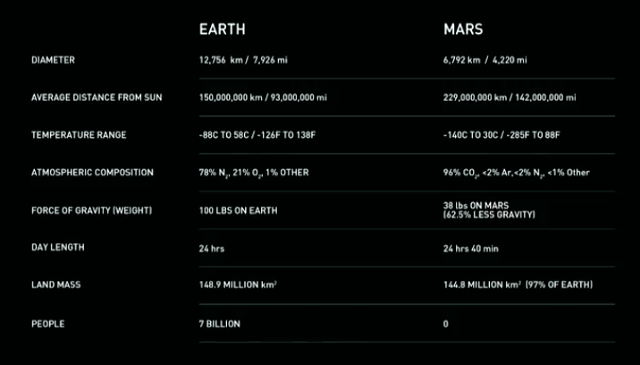
One challenge, however, is that getting to Mars is incredibly expensive. You can’t create a self-sustaining civilization if the cost is too high, Musk said. He thinks the price of going to Mars needs to come down to $200,000 to make it accessible to the average person (not that the average person would want to go right away, he admits).
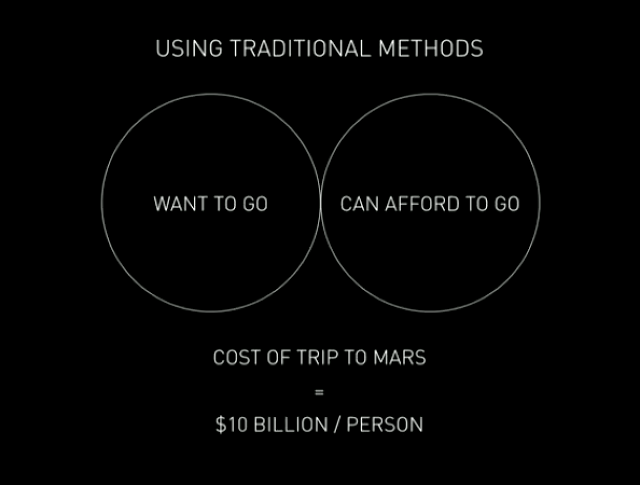
That’s why you have to build a reusable system, a rocket ship that can refuel in orbit. That would drive the cost per trip down.
You’ll also need to produce propellant on Mars, so that the rocket can take off and return home. He thinks there’s one fuel choice that’s better than the others: methane, specifically deep cryogenic methalox propellants (which are used in SpaceX’s Raptor engine). “We think methane is better almost across the board,” he said.
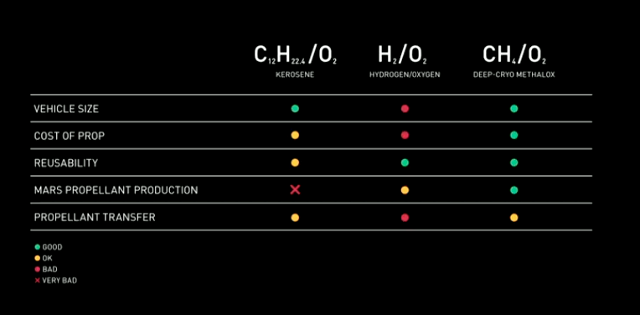
Now he cuts to the video released just before his keynote. Which is, to be fair, all CGI magic—a movie trailer for a mission to Mars. But more than what NASA has come up with at this point.
Still, Musk emphasizes that it’s all based in real science. “What you saw there is really quite close to what we actually will build,” he says. “This is not an artist’s impression. The simulation was actually made from the SpaceX engineering CAD models.”

Over time there would be many spaceships waiting in orbit, in the Interplanetary model, upwards of a thousand or more spaceships waiting in orbit. “The Mars colonial fleet would depart en masse,” he said. “Kind of like Battlestar Galactica.”
Each spaceship would have maybe 12-15 flights to Mars.
To give you a sense of the size of the complete rocket: there’s a small white speck at the bottom of the rocket on the right, and that is a human in comparison to this massive spaceship.

“This will be relatively small compared to the Mars interplanetary ships of the future,” says Musk. But for now the plan is to get 100 people and a lot of cargo on board.
Estimating a million people on Mars to establish civilization, and people can only go every two years, with at least 100 people per trip… that’s why you need ten thousand trips (and about a thousand ships).
“From the point at which the first ship goes to Mars it’s probably between 20 and 50 total Mars rendezvous, and maybe 40 to 100 years to achieve a fully self-sustaining civilization on Mars,” says Musk.

The Mars vehicle is larger than a Saturn V, making it perhaps the tallest and largest rocket ever made. He says through massive design performances the “performance bar will exceed the physical size of the rocket.” I suspect his competitors might argue otherwise, but he is claiming it’s far more performant than any other launch vehicle.
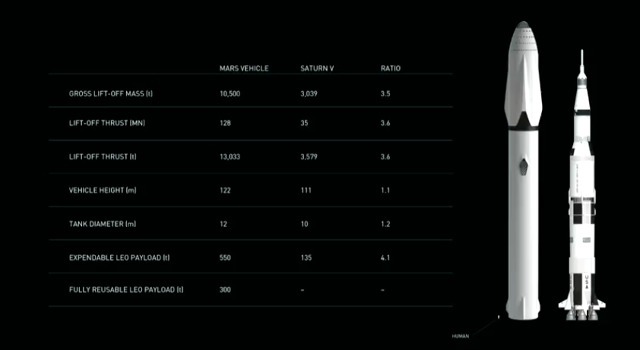
The rocket booster is a scaled up version of SpaceX’s Falcon 9.

It’s all designed so that you could lose one or multiple engines and still lift off and land safely, Musk says.

Everything for the trip, including key components that will be needed on Mars, will be flat-packed inside the cone. Cargo of up to 450 tons.
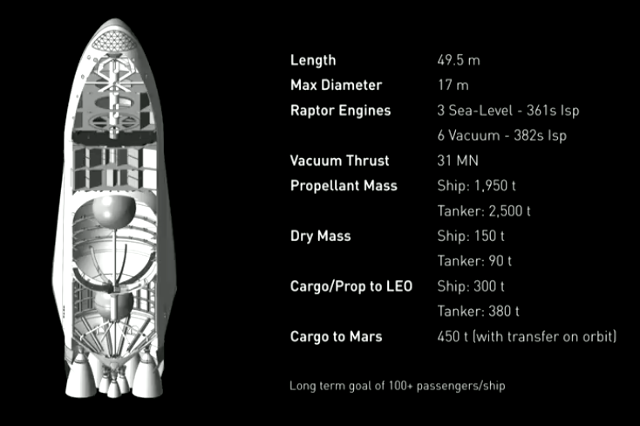
Now, how long will the trip take? Depending on which Earth-Mars you’re aiming for, “can be as low as 80 days,” says Musk. And Mars transit time of less than 30 days in the near-distant future.
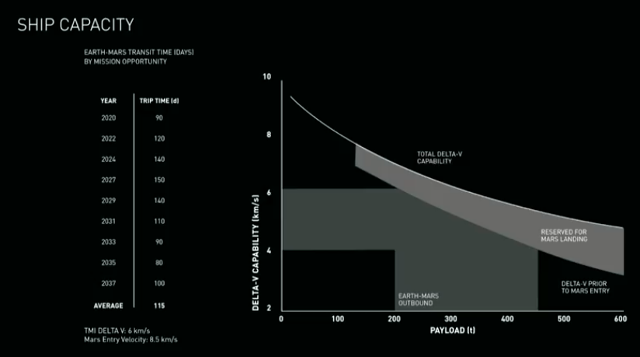
What’s it like to be in the space craft? In order to make more people want to go it’s got to feel exciting and not feel cramped. You can float around, watch movies. There will be a restaurant. “It’ll be, like, really fun to go. You’ll have a great time,” says Musk.
All yours for less than $200,000, based on his estimates. And he thinks it can drop below $100,000.
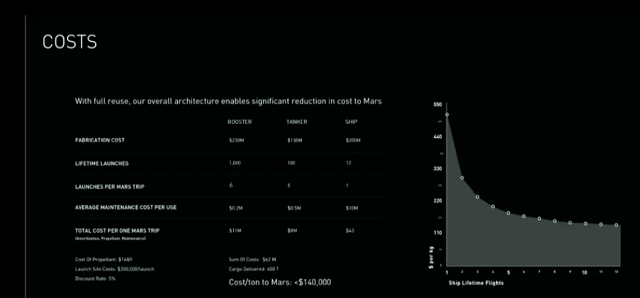
He jokes that funding could come from Kickstarter. But really it will come from launching satellites, working with NASA, and private sector funding.
“Ultimately this is going to be a huge public-private partnership,” says Musk.
As we show this is possible, and can be made real, the support will snowball over time, he says. “I really don’t have any other motivation for personally accumulating assets other than to make the biggest contribution I can to making life multiplanetary.”
Timeline: in 2002 when SpaceX was launched he thought there was a 10% chance of doing anything. “But I came to the conclusion that if there wasn’t some new entrance into the space arena without some ideological motivation,” Musk says, then we wouldn’t get to Mars.
If everything goes “super-well” then it could be as little as 10 years until the mission starts. And for every current trip to Mars they will be sending payloads to drop off, with 2 or 3 tons of useful payloads on the surface.
The test of the Raptor engine, which Musk showed off on September 26, was his hardware proof of concept for this announcement.
And they also built this carbon fiber tank and tested it with cryogenic propellant.
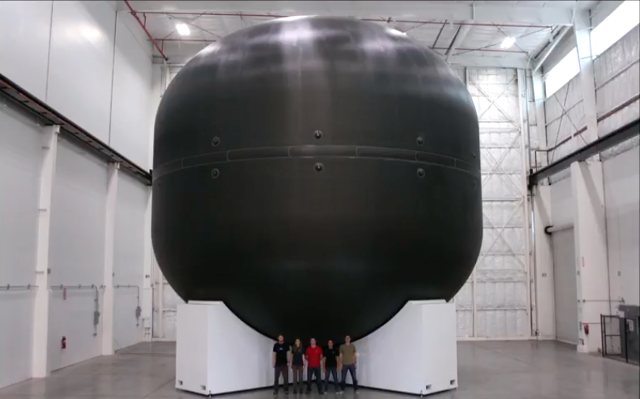
This Interplanetary System is not limited to Mars travel. It is designed to work anywhere in the solar system. “This system gives you the freedom you want to go anywhere in the Solar System,” Musk says. “Provided you have filling stations along the way.”
Interstellar travel is another story however. That might be something for another space conference.
Musk concludes his remarks and we enter into the Q&A session. We’re highlighting several interesting questions below:
Where would SpaceX build such an enormous rocket?
Musk says that it would have to be built in multiple sites throughout the world, including parts of the Middle East where large expanses of desert would provide the necessary space. The final vehicle would eventually be assembled at the launch site.
Who would be these first people who go to Mars?
These are people who would go down in history and they would need to be brave enough to risk dying. He points out that he himself is unlikely to be the first man on Mars. He wants to live long enough to see his children grow up and he would need to develop an elaborate succession plan for his business, knowing that the risk of death would be high. But creating a colony on Mars is important for the survival of the species he says. Or in a less defensive framework: going to Mars would be a great, exciting adventure, something worth waking up for every day.
How would people survive on the journey to Mars, then on the Read Planet itself?
Musk outlines a variety of technical considerations we would need to make the journey safe. But he quickly moves on to the fact that for humans to live happily on Mars, there would need to be people with a wide variety of skill sets, creating everything “from iron forgeries to pizza joints.” It’s not just about making the trip there danger-free, it’s about creating a balanced, sustainable network once we get there.
Why doesn’t SpaceX hire from an international talent-pool?
Musk explains that this is a U.S. government regulation. Working on space-related company is considered advanced weapons technology and the government restricts the number of people who can do this.
Will people be able to return from Mars?
Musk believes that it is very important for people to be able to come back, even if they don’t actually decide to do so. It makes taking the trip less risky and means that if people don’t like it or don’t fit in, they can always return to their home planet. “A flight to Mars will always include a return ticket,” he quips.
How can people at this conference contribute to Musk’s work?
He believes believes that the more companies that are working on space-related endeavors the better. His reason for coming to this conference was to get more people involved in this project: they might compete with SpaceX or collaborate. Whatever the case, the more people working to solve the problem the better. But Musk says that even the entertainment industry could play a role in this mission. Getting people excited about the possibility of going to Mars and building popular support is important for what SpaceX is trying to do. It’s about sparking people’s imagination.
On that note, the panel ends, and Musk leaves the stage.
Fast Company , Read Full Story
(87)

